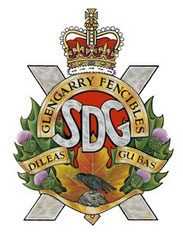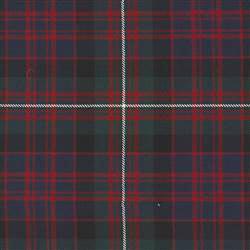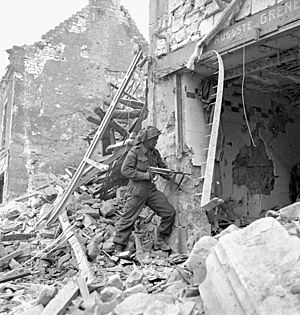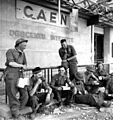Stormont, Dundas and Glengarry Highlanders facts for kids
Quick facts for kids Stormont, Dundas and Glengarry Highlanders |
|
|---|---|
| Active | 1868–present |
| Country | |
| Branch | Infantry |
| Type | Infantry |
| Role | Light role |
| Size | One battalion |
| Part of | 33 Canadian Brigade Group |
| Garrison/HQ | Cornwall, Ontario |
| Nickname(s) | "Glengarrians" or "The Glens" |
| Motto(s) | Scottish Gaelic: Dileas gu bas (Faithful unto death) |
| March | "Bonnie Dundee" |
| Anniversaries | Regimental Birthday 3 July |
| Engagements | War of 1812 Upper Canada Rebellion World War I World War II Afghanistan |
| Commanders | |
| Colonel-in-Chief | Queen Elizabeth II |
| Honorary Colonel | VACANT |
| Honorary Lieutenant-Colonel | VACANT |
| Commanding Officer | LCol R.S.Hartman, CD |
| Regimental Sergeant-Major | CWO J.F. Lessard, CD |
| Insignia | |
| Tartan | MacDonnell of Glengarry |
The Stormont, Dundas and Glengarry Highlanders is a special army group in Canada. It's a Primary Reserve infantry regiment, which means its members are part-time soldiers who train regularly and can be called upon when needed. This group is part of the Canadian Army and is based in Cornwall, Ontario. They are often called "Glengarrians" or "The Glens." Their motto, "Dileas gu bas," means "Faithful unto death."
Contents
How the Regiment Started
The Stormont, Dundas and Glengarry Highlanders began in Cornwall, Ontario, on July 3, 1868. It was first known as the 59th "Stormont and Glengarry Battalion of Infantry." Over the years, its name changed several times. It became "The Stormont, Dundas and Glengarry Highlanders" on February 15, 1922. This name has stayed mostly the same since then.
The regiment honors older military groups from the area. These include local militia units that fought in the War of 1812. They also honor the Glengarry Light Infantry Fencibles, a British army unit from that war. This connection means the Highlanders carry on the history of these brave soldiers.
Fighting for Canada
Early Days and Fenian Raids
The regiment's first call to action was during the Fenian Raids. These were attacks by Irish-American groups on Canadian borders. In May 1870, the battalion helped guard the St. Lawrence River. They served for a short time before the danger passed.
The Great War (World War I)
When World War I started in 1914, the regiment helped protect the St. Lawrence canals. Later, in 1915, a new battalion was formed from the area, called the 154th Battalion. This battalion went overseas to Great Britain. Its soldiers were used to reinforce other Canadian units fighting in Europe. Many brave soldiers from the 154th Battalion were killed or wounded.
One famous soldier, Claude Joseph Patrick Nunney, joined the regiment before the war. He later earned the Victoria Cross, Canada's highest award for bravery, in 1918.
The Second World War
When World War II began, the regiment again guarded the St. Lawrence canals. In 1940, a special overseas battalion was formed. This battalion went to England in 1941.
On D-Day, June 6, 1944, the Stormont, Dundas and Glengarry Highlanders landed in Normandy, France. They were among the first Allied troops to enter Caen on July 9, 1944. The fighting was very tough. In just 55 days, 112 Highlanders were killed and 312 were wounded in the Falaise Gap.
The regiment continued to fight across France and into the Netherlands. They took part in important battles like the crossing of the Savojaardsplaat and the advance to Knokke. They also helped guard a bridge near Nijmegen for the Rhine crossing. Their final actions in the war included fighting through the Hochwald and taking the city of Leer. The war ended for them near Emden on May 3, 1945.
It is said that the regiment "never failed to take an objective; never lost a yard of ground; never lost a man taken prisoner in offensive action." This shows their incredible bravery and determination. Over 3,300 soldiers from the regiment served overseas in World War II.
War in Afghanistan
More recently, between 2002 and 2014, the regiment sent many of its soldiers to serve in Afghanistan. They made up more than 20% of their total strength in various missions. One soldier, Corporal Eric Monnin, received the Medal of Military Valour for his brave actions in Afghanistan in 2010.
Battle Honours: A Mark of Bravery
Battle honours are special awards given to military units for their courage and success in battles or campaigns. They are like badges of honor that show where the regiment has fought bravely. Some of these honours are proudly displayed on the regiment's flag, called the regimental colour.
Here are some of the important battle honours earned by the Stormont, Dundas and Glengarry Highlanders:
War of 1812 Honours
- Defence of Canada – 1812–1815
- Crysler's Farm
- Niagara (This honour is for the Glengarry Light Infantry Fencibles, whom the regiment perpetuates.)
Great War Honours
- Hill 70
- Ypres, 1917
- Amiens
- Arras, 1918
- Hindenburg Line
- Pursuit to Mons
Second World War Honours
- Normandy Landing
- Caen
- Falaise
- Boulogne, 1944
- The Scheldt
- Breskens Pocket
- The Rhineland
- The Hochwald
- The Rhine
- Leer
- North West Europe, 1944–1945
War in Afghanistan Honour
- Afghanistan
Regimental Badge and Tartan
The Stormont, Dundas and Glengarry Highlanders have a unique badge. It features the letters "SDG" on a background of thistle leaves and flowers. Below this, there is a raven on a rock, placed on a maple leaf. Scrolls say "DILEAS GU BAS," which is their motto. Above, a circle says "GLENGARRY FENCIBLES," topped with a Crown. The whole design is on a Saint Andrew’s cross.
The regiment wears a special pattern of plaid fabric called a tartan. Their tartan is the "Macdonell of Glengarry" tartan. This connects them to the Scottish heritage of many of the early settlers in the Glengarry area.
Regimental Museum
| Location | The Stormont, Dundas and Glengarry Highlanders, Cornwall Armoury 505 Fourth Street East, Cornwall, Ontario K6H 2S7 Canada |
|---|---|
| Type | Regimental Museum |
The Stormont, Dundas and Glengarry Highlanders have their own museum. It is located at the Cornwall Armoury. The museum collects and displays military items and old documents. These items tell the story of the regiment and its past units. They also show the military experiences of people from the Stormont, Dundas, and Glengarry counties.
Important Locations and Memorials
The main home of the regiment is the Cornwall Armoury. This building was built in 1938–39. It is recognized as a heritage building in Canada.
There are many monuments, plaques, and honour rolls that remember the soldiers of the Stormont, Dundas and Glengarry Highlanders. These memorials are found in places like the Cornwall Armoury, and even in France and Belgium, where the regiment fought in World War II.
For example, there are plaques and honour rolls for the 154th Battalion and the 1st Battalion at the Cornwall Armoury. In France, there are monuments and plaques in places like Caen and Les Buissons, where the Highlanders fought bravely. These memorials help everyone remember the sacrifices made by the soldiers.
The old flags (Colours) of the 59th Battalion are kept in the Officers' Mess. The Colours of the 154th Battalion are in the Trinity Anglican Church in Cornwall, Ontario.
Images for kids









